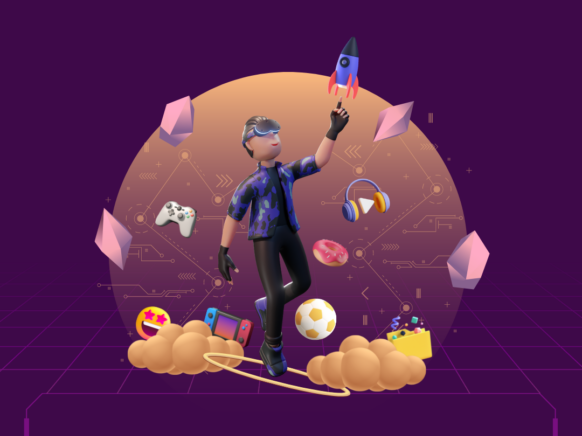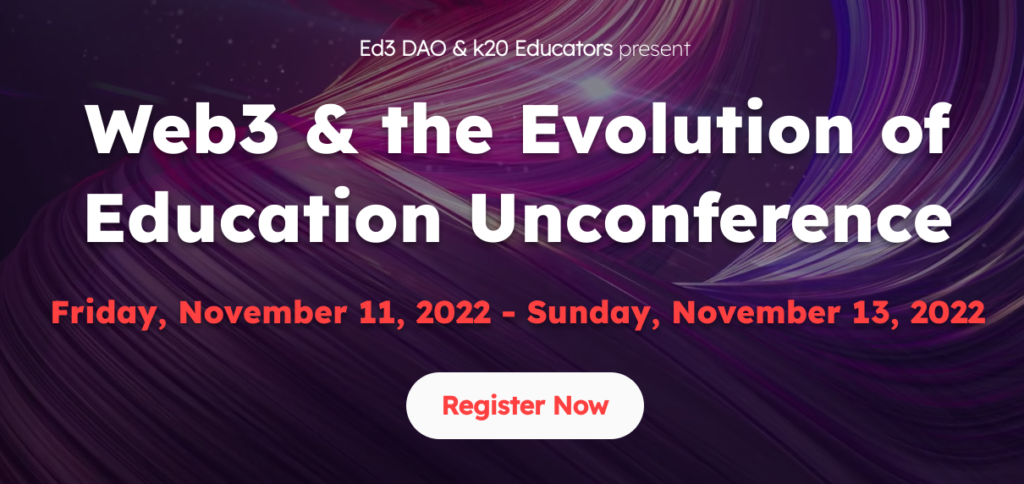Post by Tom Daccord
For many educators, the “metaverse” is but a vague and extraneous concept. And that’s understandable. But, metaverse technologies are growing quickly and have enormous implications for the future of teaching and learning. As such, the following Q&A aims to introduce EdTechTeacher readers to the metaverse and how it may impact education.
What is the metaverse?
Put simply, the metaverse is a virtual version of the real world. It lives in a network of interconnected computers and includes a range of free, accessible, and decentralized games, communities, and venues for interaction. In the metaverse, anyone can join or create interactive digital spaces. It signifies a radical change in the way we engage in virtual spaces and interact with other humans.
How does it work?
The metaverse leverages artificial intelligence, augmented reality, virtual reality, and “Web3” to create immersive, 3D, real-time, and interactive social environments. In these environments, metaverse users can interact with each other, build things (in groups or alone), play games and interact with avatars and 3D digital objects.
Does the metaverse exist now?
The metaverse only partially exists. There are online, interactive worlds that provide a “metaverse experience,” but these are not interconnected and provide only limited social interaction. That said, the metaverse’s underlying technologies are expanding rapidly and many experts believe the metaverse will become ubiquitous in the near future.
What are some examples of the metaverse?
For many, its most recognizable forms are games, such as Minecraft, Fortnite, and Roblox. These are online, interactive “virtual worlds”, with social interaction and feature avatars and 3D digital objects.
Associated technologies include blockchain, a “digital ledger” of transactions that are difficult to hack or change, and NFTs (non-fungible tokens), a high-tech way to replicate real-world items as digital files. Also associated is Web3, a vision of a revamped and decentralized Web where users own their online activities. In all, these technologies help create systems for individuals and businesses to own, buy, share or sell goods.
Is the metaverse being used in education now?
Yes and no.
Minecraft is being incorporated in K-12 education. For example, high school teacher and EdTechTeacher instructor Douglas Kiang designed an Underwater Dome Project for his computer science students to build community and encourage teamwork in his face-to-face classroom. Kiang found it led to a “truly profound collaboration” amongst his students.
Furthermore, Avantis Education recently introduced Eduverse, a web-based “safe and secure” K-12 metaverse experience for classrooms. In Eduverse, students interact as avatars in a VR environment and can explore Eduverse on their own or with classmates in a teacher-controlled space. In addition, Eduverse provides access to educational VR content and offers the “first educational VR theme park.”
Also, K20 Educators is a new social learning network where educators can meet in the metaverse (“eduverse”) and learn about fundamental metaverse technologies. The goal of the network is to prepare teachers for the metaverse by providing “meaningful & innovative professional learning experiences.”
Underlying metaverse technologies have also been in use in education for some time.
One example is Virtual Reality (VR). VR enables the creation of immersive learning experiences that can help enhance student understanding of a topic. VR enables users with VR headsets to become immersed in an array of real-world or fictional environments. One such learning experience is Becoming Homeless: A Human Experience from the Stanford Virtual Human Interaction Lab where participants spend days in the life of a person who can no longer afford a home and interact with different environments in an attempt to save the home. Stanford researchers have found that the VR experience “changes helping behavior” and its impact lasts months afterward.
Another underlying metaverse technology is Augmented Reality (AR). With AR, one can overlay images, videos, and sounds onto an existing environment to “augment” a real-world scenario. (Unlike VR, no goggles or headsets are required and the experiences are not fully immersive.) One simple use of AR is to augment classroom materials. For instance, images, videos, and sounds of a World War II battle could be superimposed on a textbook page describing a World Word II. In a similar vein, images, videos, and sounds of the human heart might be superimposed on reading material describing the workings of the heart. So, AR can assist in the creation of personalized, multimedia learning materials.
But VR and AR platforms lack social interaction and are not interconnected with each other. They fall short of a truly metaverse environment.
A transformative third associated metaverse technology is artificial intelligence (AI). Artificial intelligence enables computers to perform tasks commonly associated with human intellectual processes. AI is creating dramatic transformations in the workplace, as computers replace human labor, but AI in education has been largely limited to tutoring software that aims to make curriculum materials more individualized for students. One example is Knewton, an AI-powered platform that tailors personalized lesson plans to students. These so-called “adaptive” or “personalized” AI-infused learning platforms are increasingly being introduced into schools and universities. But these fall well short of a metaverse experience of interconnected, virtual social interaction.
That said, an educational world of “virtual humans” is beginning to emerge. Neon, the world’s first “Artificial Human,” was introduced by Samsung-funded Star Labs in 2020. Neon is a photo-realistic videobot of a human being that can move, talk and smile “with such authenticity that it is impossible to tell they are computer-generated.” Neons can learn things about their user, speak in any language, and are being marketed as educational tutors.
Furthermore, AI instructors have begun to emerge. For example, AV1 is a distance-learning robot in the UK that allows children suffering from long-term illness to attend school. AV1 acts as a proxy for the student; it can raise its hand, share with the class, or speak quietly with classmates. In China, 600 kindergarten classes have embraced Keeko, an autonomous robot that can tell stories and pose riddles. Keeko reads stories while prompting students for predictions, plays educational games, recalls conversations, and recognizes faces.
AI is also impacting language processing and writing in ways that may startle educators. Recently, a new AI tool was released called GPT-3. “Generative Pre-trained Transformer, Version 3” absorbs and analyzes an enormous amount of text on the Internet and in other publications and leverages this information to write stories, create characters, provide sensory description, craft poetic language, and more. GPT-3 requires only a small amount of text from a user to write language “impressively” and “human-sounding.” As I explain in this article, GPT-3 is one of many “enormous ethical and pedagogical AI challenges facing educators”.
In general, AI will support the metaverse by (among other things) creating digital humans such as 3D chatbots or videobots that interact with humans in the metaverse. AI will also help users with language processing so one can interact fluidly in the Metaverse. Educators will be forced to consider the extent to which they will be introduced into teaching and learning.
How will the metaverse impact education in the future?
There are many unknowns, but here are a few potential scenarios.
- Broadly speaking, the metaverse will enable many students to learn in fully immersive and multimedia environments that leverage both the physical and digital worlds. For instance, in a geometry class students might learn geometric equations by seeing and manipulating geometric shapes in a VR environment while at the same time listening to an expert mathematician provide context and guidance. Students could also be solving geometric problems in a collaborative, virtual environment with students halfway across the globe. Students might be active virtually in an architect’s or engineer’s office examining plans of newly designed city buildings to understand how mathematical principles are applied in practice. Students will work both individually and collectively, at times on different tasks and at varied paces. At certain junctures, the teacher will converse with students in a fully physical environment to review their progress, engender a discussion, and probe for evidence of thoughtful problem solving. In all, an enriched metaverse learning environment would blend both physical and virtual worlds and would leverage multimedia to provide diverse learning opportunities for students in a collaborative setting.
- Learning will become more decentralized and metaverse programs (or “metaverse schools”) will emerge as students increasingly seek immersive, interactive, and engaging online learning environments. In a decentralized learning environment, students are no longer bound by the physical or formal constraints imposed by school or university administrators. Students and their parents will search for alternatives to brick-and-mortar learning and traditional pen-and-paper, teacher-centered learning. More immersive alternatives will emerge, such as the STEM metaverse for children aged 6-14 that leverages live virtual multiplayer gaming to learn science topics. By offering students engaging alternatives to brick-and-mortar learning, schools and universities may be better positioned to tackle problems related to lack of physical space, student disengagement, and teacher shortages. In all, as more diverse and immersive online learning experiences emerge there will be more challenges to traditional pedagogy and programs.
- Learning will become more gamified. Virtual learning activities will increasingly include game mechanics and game-design elements, such as competition, points and rewards. Fully immersive 3D VR and AR worlds will place the users inside games and go beyond the limits of 2D game screens. As gamified elements become more immersive and engaging they are likely to become more popular with children and young people. The global game-based learning market size is expected to increase nearly 20% in the next five years and as demand for augmented reality, virtual reality, and artificial intelligence in education rise, so likely will demand for gamified learning activities. Roblox, one of the most popular gaming environments for children, has roughly 55 million daily users and a reported three-fourths of all U.S. kids between 9 and 12 years old were playing Roblox in 2020. Even now, 2D educational games such as Kahoot are extremely popular with students (and teachers). many popular educational platforms include gamified elements.
- Educators and parents will struggle with how the metaverse should be integrated in teaching and learning. The metaverse offers an unlimited number of educational possibilities, but the risks to children are unknown at this point. In fully immersive 3D VR and AR worlds, students are inside their environments and what is transpiring around them may not be readily available or apparent to adults. This will likely trouble parents. Also, how will children react emotionally as they are exposed to more-and-more “realistic” 3D VR and AR environments? What happens to children if the difference between reality and fantasy starts to become unclear to them? These are but a few of the complex issues related to children in a metaverse environment.
Interested in learning more about the metaverse / web3 and joining a community of educators exploring these ideas? We highly recommend participating in the upcoming Ed3 Unconference. You can find our more info and register here. You can also get a 5% discount when entered in the code “Edtechteacher5.”



